#Dazaifu tenmangu shrine
Text
Murderous grudge turned into God of learning, Dazaifu Tenmangu shrine in Fukuoka prefecture!!
Murderous grudge turned into God of learning, Dazaifu Tenmangu shrine in Fukuoka prefecture!!
Hi I’m Nobu, I like traveling overseas and in Japan, visited 26 countries!
I’m a National Government Licensed Guide Interpreter of English for 10 years.
For the people who are interested in and planning trip to Japan ,I show you hidden local information which you have never seen and heard of through…

View On WordPress
1 note
·
View note
Text
日本のトリビアまとめ #0002
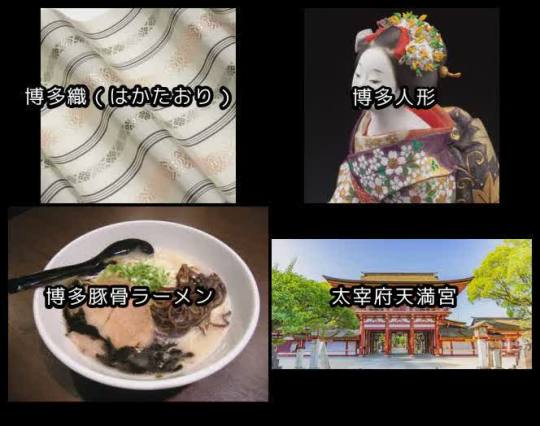
#博多の伝統工芸#Traditional textiles of Hakata#博多の食文化#博多織(はかたおり)#Hakata Tonkotsu ramen#Traditional crafts of Hakata#だざいふてんまんぐう#福岡の織物#Hakata food culture#Hakata-ori#Dazaifu Tenmangu Shrine#Dazaiftenmanguu#Japanese Trivia#Hakata doll#博多人形#太宰府天満宮#博多豚骨ラーメン#日本のトリビア
0 notes
Photo

太宰府天満宮
だざいふてんまんぐう
太宰府天満宮(だざいふてんまんぐう)は、福岡県太宰府市に位置する神社で、菅原道真(すがわらのみちざね)を祀っています。以下に、太宰府天満宮に関する詳細を説明します。
1. 歴史と由来:
太宰府天満宮は、平安時代の学者・政治家であった菅原道真を祀る神社として知られています。道真は、学問や文化の神として尊敬され、彼の死後、天神信仰の中心的存在となりました。彼を祀るため、多くの天満宮が全国各地に建てられましたが、太宰府天満宮はその中でも最も格式の高いもののひとつです。
2. 境内と建造物:
太宰府天満宮の境内には、豊かな自然と歴史的な建造物があります。本殿や拝殿、鳥居などの建築物は、古来の様式を残しつつ、度重なる改修や再建が行われています。境内には、梅の木や枝垂れ桜など季節ごとの花々が美しい景観を作り出しています。
3. 節分祭や学業成就:
太宰府天満宮では、毎年2月25日に菅原道真の命日を祝う「節分祭」が行われます。多くの参拝者が訪れ、豆まきや行列が行われます。また、学業成就や試験合格の祈願をする場所としても知られ、試験シーズンには多くの受験生やその家族が訪れます。
4. 文化財:
太宰府天満宮の境内には、多くの文化財や歴史的な遺物があります。国の重要文化財に指定された建造物や史跡があり、歴史や文化に興味を持つ人々にとって貴重な場所です。
♪♫♬🎤🎹🎶♪♫♬🎤🎹🎶♪♫♬🎤🎹🎶♪♫♬🎤🎹🎶
Dazaifu Tenmangu
Cultural assets of Saga
Dazaifu Tenmangu is a shrine located in Dazaifu City, Fukuoka Prefecture, and is dedicated to Michizane Sugawara. Below are details about Dazaifu Tenmangu Shrine.
1. History and origin:
Dazaifu Tenmangu Shrine is known as the shrine that enshrines Michizane Sugawara, a scholar and politician from the Heian period. Michizane was revered as the god of learning and culture, and after his death, he became a central figure in Tenjin worship. Many Tenmangu shrines were built all over the country to enshrine him, but Dazaifu Tenmangu Shrine is one of the most prestigious.
2. Precincts and buildings:
The precincts of Dazaifu Tenmangu Shrine are home to rich nature and historical buildings. Buildings such as the main shrine, worship hall, and torii gate have been repeatedly renovated and rebuilt while preserving their ancient style. In the precincts, seasonal flowers such as plum trees and weeping cherry blossoms create a beautiful landscape.
3. Setsubun festival and academic achievement:
At Dazaifu Tenmangu Shrine, the Setsubun Festival is held on February 25th every year to celebrate the anniversary of Michizane Sugawara's death. Many worshipers visit, and there is a bean-throwing event and a procession. It is also known as a place to pray for academic success and exam passing, and many examinees and their families visit during exam season.
4. Cultural properties:
0 notes
Video
youtube
[太宰府天満宮公式チャンネル] Introducing the world of shrine maidens - 巫女 MIKO
Beautiful, respectful and graceful. Enter the world of Miko.
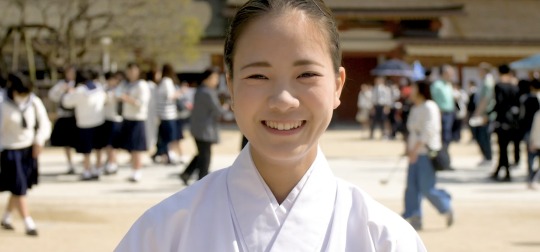
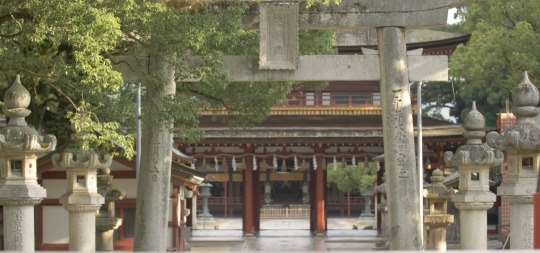

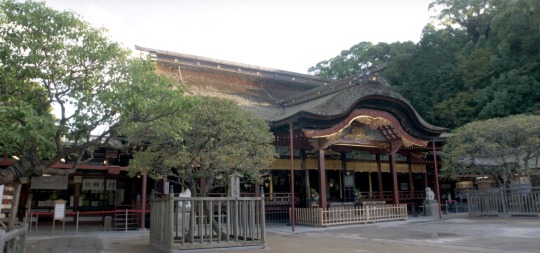
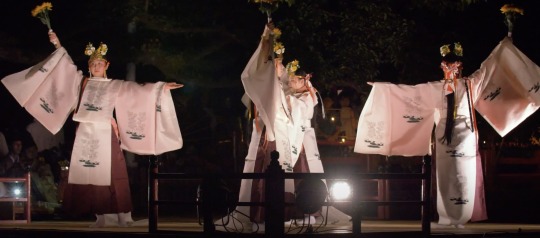
#shrine maiden#shinto shrine#miko#japan#japanese culture#japanese tradition#Dazaifu Tenmangu#daizafu#fukuoka prefecture
58 notes
·
View notes
Text

The latest piece is dedicated to the Nishitetsu Group's TV ad, "Dazaifu."
Nishitetsu Dazaifu Station is embellished with elements from Dazaifu Tenmangu Shrine, which has a thousand-year history ⛩✨
This is the concluding work of the Nishitetsu TV commercial series.
It has been an honor to be a part of the project, and I am extremely grateful for the opportunity.
Check out the animation on YouTube!
#art work#illustration#illustrator#digital art#digital painting#digital drawing#digital illustration#animation#anime art#japan art#bus
36 notes
·
View notes
Text
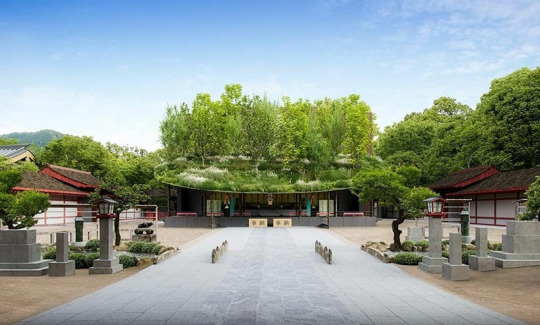

sou fujimoto crowns temporary shrine in japan with planted bent roof
Dazaifu Tenmangu Shrine is the head shrine of Tenmangu shrines in Japan that permanently enshrines the spirit of Sugawara no Michizane, who is widely revered as the god of learning, culture, art, and sincerity. The shrine is worshiped not only all over Japan but also around the world, and nearly 10 million worshipers visit it annually.
157 notes
·
View notes
Text

EGARATE Shrine, giant ginkgo tree. 900-year-old
鎌倉市の荏柄天神社
【Türkçe aşağıda gösterilmiştir】
This section introduces the Egara Tenjinsha shrine in Kamakura and its beautiful sacred tree. It takes about 60 minutes from Tokyo Station to Kamakura Station.
Egara Tenjinsha is dedicated to Sugawara no Michizane, the god of learning. Michizane lived from 845 to 903 and is widely worshipped as a god of learning who helps those who aspire to study and honesty.
The shrine dates back to the first year of Chouji (1104). One fine day, the sky suddenly darkened, and with a thunderstorm, the image of a heavenly god in a black sashes descended from the sky. The villagers, fearing the power of the deity, decided to build a shrine to house and worship the image. The shrine has branches in various parts of Japan, mainly in the Kanto region, and is one of the three oldest Shinto shrines, along with Dazaifu Tenmangu Shrine in Fukuoka and Kitano Tenmangu Shrine in Kyoto.
When visiting the shrine, please ring the bell and bow in the manner of Nirei, Ni-rei, Ni-applause, Ichirei.
Egara Tenjinsha has a sacred tree called Oiginko. According to an old historical document, the villagers planted the ginkgo tree to prevent it from being trampled on because they were in awe of the place where the image of the god Tenjin had descended from the heavens. Therefore, this large ginkgo tree is believed to be around 900 years old, just like the shrine. At 25 metres high and 10 metres in girth, this large tree has an overwhelming presence.
The ginkgo tree is very beautiful in autumn, when it turns golden.
Characteristics of ginkgo nuts and how to eat them
Ginkgo nuts have a unique flavour and texture and are used in a variety of dishes. Common cooking methods include
Stir-frying: ginkgo nuts can be lightly roasted in a pan and sprinkled with salt to make a tasty and savoury snack.
Boiling: Boil ginkgo nuts quickly in boiling water to soften them and make them easier to use in salads and salad dressings.
Chawanmushi: Adding ginkgo nuts as an ingredient in chawanmushi adds a subtle sweetness and a unique flavour to the dish.
It is safe to use around 10 ginkgo nuts per day for adults and 5 for children.
Allergy note: Some people may have allergic reactions to ginkgo biloba. Try small amounts when eating them for the first time.
Proper cooking: ginkgo nuts should be cooked thoroughly before eating. Eating them raw may cause indigestion.
Ginkgo nuts are harvested in autumn and are a popular autumn delicacy. Gingko nuts are often served at Japanese autumn festivals and events in particular, and are enjoyed as a dish that reminds people of the changing seasons.
When visiting Egara Tenjinsha, feel the presence of the large ginkgo trees and ponder the taste and nutritional value of their fruit.
Also, on 8 February, a ceremony is held to offer needles. Used needles are inserted into 'soft tofu', to honour their spirits and pray for the improvement of their skills.
Click here for access to Egara Tenjinsha:
74 Nikaido, Kamakura, Kanagawa 248-0002, Japan.
Egara Tenjinsha is conveniently accessible by foot or bus from Kamakura Station.
From Kamakura Station on foot: It takes about 30 minutes on foot from the East Exit of Kamakura Station.
By bus: take the Keikyu bus from the east exit of Kamakura Station and get off at the Sugimoto-dera bus stop, from where it is a 5-minute walk.
As Kamakura city is dotted with tourist attractions, it is recommended to enjoy a walk around the city.

Egara Tenjinsha is a special place where ancient history and natural beauty merge. Why not pay a visit?
Bu bölümde Kamakura'daki Egara Tenjinsha tapınağı ve onun güzel kutsal ağacı tanıtılmaktadır. Tokyo İstasyonu ile Kamakura İstasyonu arası yaklaşık 60 dakika sürmektedir.
Egara Tenjinsha, öğrenme tanrısı Sugawara no Michizane'ye adanmıştır. Michizane 845-903 yılları arasında yaşamıştır ve çalışma ve dürüstlük isteyenlere yardım eden bir öğrenme tanrısı olarak yaygın bir şekilde tapınılmaktadır.
Tapınağın tarihi Chouji'nin ilk yılına (1104) kadar uzanmaktadır. Güzel bir günde gökyüzü aniden karardı ve gök gürültülü bir fırtına ile birlikte siyah kuşaklı göksel bir tanrı görüntüsü gökyüzünden indi. Tanrının gücünden korkan köylüler, görüntüyü barındırmak ve ona tapınmak için bir tapınak inşa etmeye karar verirler. Başta Kanto bölgesi olmak üzere Japonya'nın çeşitli yerlerinde şubeleri bulunan tapınak, Fukuoka'daki Dazaifu Tenmangu Tapınağı ve Kyoto'daki Kitano Tenmangu Tapınağı ile birlikte en eski üç Şinto tapınağından biridir.
Tapınağı ziyaret ederken lütfen çanı çalın ve Nirei, Ni-rei, Ni-applause, Ichirei şeklinde selam verin.
Egara Tenjinsha'nın Oiginko adında kutsal bir ağacı vardır. Eski bir tarihi belgeye göre, köylüler bu ginkgo ağacını, tanrı Tenjin'in göklerden inen görüntüsünün bulunduğu yere huşu duydukları için çiğnenmesini önlemek amacıyla dikmişlerdir. Bu nedenle, bu büyük ginkgo ağacının da tıpkı tapınak gibi yaklaşık 900 yaşında olduğuna inanılıyor. 25 metre yüksekliğinde ve 10 metre genişliğindeki bu büyük ağaç, ezici bir varlığa sahiptir.
Ginkgo ağacı sonbaharda altın rengine büründüğünde çok güzeldir.
Ginkgo fıstığının özellikleri ve nasıl yeneceği
Ginkgo fıstığı eşsiz bir lezzet ve dokuya sahiptir ve çeşitli yemeklerde kullanılır. Yaygın pişirme yöntemleri şunları içerir
Karıştırarak kızartma: Ginkgo fıstığı tavada hafifçe kavrulabilir ve üzerine tuz serpilerek lezzetli ve tuzlu bir atıştırmalık haline getirilebilir.
Haşlama: Ginkgo fındıklarını yumuşatmak ve salatalarda ve salata soslarında kullanımını kolaylaştırmak için kaynar suda hızlıca haşlayın.
Chawanmushi: Chawanmushi'ye bir bileşen olarak ginkgo fıstığı eklemek yemeğe hafif bir tatlılık ve eşsiz bir lezzet katar.
Yetişkinler için günde yaklaşık 10, çocuklar içinse 5 ginkgo fındığı kullanmak güvenlidir.
Alerji notu: Bazı insanlar ginkgo biloba'ya karşı alerjik reaksiyon gösterebilir. İlk kez yerken küçük miktarlarda deneyin.
Doğru pişirme: Ginkgo fıstığı yemeden önce iyice pişirilmelidir. Çiğ olarak yemek hazımsızlığa neden olabilir.
Ginkgo fıstığı sonbaharda hasat edilir ve popüler bir sonbahar lezzetidir. Gingko fıstığı özellikle Japon sonbahar festivallerinde ve etkinliklerinde sık sık servis edilir ve insanlara değişen mevsimleri hatırlatan bir yemek olarak beğenilir.
Egara Tenjinsha'yı ziyaret ederken, büyük ginkgo ağaçlarının varlığını hissedin ve meyvelerinin tadı ve besin değeri üzerine düşünün.
Ayrıca, 8 Şubat'ta iğneler sunmak için bir tören düzenlenir. Kullanılmış iğneler, ruhlarını onurlandırmak ve becerilerinin gelişmesi için dua etmek amacıyla 'yumuşak tofu'nun içine yerleştirilir.
Egara Tenjinsha'ya erişim için buraya tıklayın:
74 Nikaido, Kamakura, Kanagawa 248-0002, Japonya.
Egara Tenjinsha'ya Kamakura İstasyonu'ndan yürüyerek veya otobüsle rahatlıkla ulaşılabilir.
Kamakura İstasyonu'ndan yürüyerek: Kamakura İstasyonu'nun Doğu Çıkışı'ndan yürüyerek yaklaşık 30 dakika sürer.
Otobüsle: Kamakura İstasyonu'nun doğu çıkışından Keikyu otobüsüne binin ve 5 dakikalık yürüme mesafesindeki Sugimoto-dera otobüs durağında inin.
Kamakura şehri turistik mekanlarla dolu olduğundan, şehirde bir yürüyüşün tadını çıkarmanız önerilir.
Egara Tenjinsha, antik tarih ve doğal güzelliğin birleştiği özel bir yerdir. Neden ziyaret etmiyorsunuz?
2 notes
·
View notes
Photo

Found this photo of me while cleaning and sorting things today. This must be at least 17 years old. It was taken on the three bridges that lead into the entrance of Dazaifu Tenmangu Shrine, dedicated to Michezane-sama, the god of scholars and writers. I am delighted an amazed to be able to look back on this photo and know for a fact that I received what I prayed for. (at Dazaifu Tenmangu Shrine, Fukuoka) https://www.instagram.com/p/CoQI3sRPf_N/?igshid=NGJjMDIxMWI=
8 notes
·
View notes
Photo

Tourists entering one of Kyushu's most important Shinto Shrines, the Dazaifu Tenmangu Shrine (太宰府天満宮) — view on Instagram https://ift.tt/xsb173K
2 notes
·
View notes
Text
Photo of the Day: Dazaifu Starbucks
Starbucks in Japan seem to be a little different than here in the States. I have come across several specially designed stores in Japan outside of the normal Starbucks fare. This one is along a promenade leading up to Tenmangu Shrine, a very popular shrine.
The shrine is dedicated to scholars. The deity was actually a real person, Sugawara Michizane. He had been exiled to Kyushu, where he ended…

View On WordPress
0 notes
Text
Ushijima Shrine Ushijima Shrine where Ushi-oni is enshrined Incarnation of Susano-no-mikoto
Ushijima Shrine, a Shinto shrine founded by the Buddhist monk Jikaku Daishi Ennin
Since it has been in existence for more than 1,000 years, old remains are casually placed here and there.
At first, I visited the shrine mistaking it for a Dazaifu Tenmangu shrine because of the word "Ushijima" in the name,
However, the atmosphere was completely different.
There is a mysterious legend in "Azuma-kan" (Azuma's Book of History) from the Kamakura period.
In the third year of Kencho (1251), a bull-like apparition appeared in Sensoji Temple, and 24 monks in the dining hall became ill.
The 24 monks in the dining hall became ill and seven died.
This bull demon ran around the shrine, jumped into Ushijima Shrine, and dropped a ball of beef that he went and made into a sacred treasure of Ushijima Shrine….
What happened to the Ushi-oni is not depicted, but if it were, it might have been sealed and enshrined at Ushijima Shrine.
The shrine is somehow as elegant and boxy as Kyoto . It is not only pure and clean, but also has a mysterious atmosphere of deep darkness.
youtube
1 note
·
View note
Photo

Look at this shot (((o(*゚▽゚*)o)))♡ I’ve got another great post from Fukuoka, Japan. Oh yes!! The custom “Black Sakura” blooms on Leica M11(^O^☆♪ I like that also Dazaifu Tenmangu Shrine red lantern background. So beautiful and so much Japan in it ٩(^‿^)۶ Thank you so much for sharing your photos again @good_feeling_lab enjoy it (^人^)いつもありがとうございます! (Dazaifu Tenmangu Shrine) https://www.instagram.com/p/CqQmaczSsxE/?igshid=NGJjMDIxMWI=
0 notes
Text

Friday January 6/2023
We left our hotel at 6:00 am to catch a flight to Fukuoka. At the airport everything was done by computers (self check-in method), so we didn’t have to interact with any humans. We got our boarding pass, weighed our luggage and the machines printed tags for them. Then we put them on a railing system to go to the right gate. While waiting for our departure, I explored couple of shops , and bought black coffee in a bottle with a jam sandwich. It was an enjoyable experience.
Kota picked us up around noon and we visited the Dazaifu Tenmangu Shrine. We walked on a narrow stone road among various vendors shops to get there. On arrival, we walked over 3 bridges that were a symbolic of connection between past, present, and future. The scenery was gorgeous! Beautiful old plum trees, many ponds and typical manicured Japanese gardens were impressive. Washing hands was important before entering the shrine. I got an amulet prayer and fortune for my donation. I experienced the peacefulness of the place and enjoyed watching young girls in their traditional kimono dresses.
We walked uphills to higher shrine that had a bell to shake to awaken the god to hear your prayers! Along the way, there were many fox statues that were symbol of money and wealth.
Before we checked into our hotel, we visited the 800 years old shrine. The very simple wooden Structure was most impressive. I learned something today. “Shrines are for worshipping one’s gods, and temples are for worshiping one’s ancestors”
Simon had a bunch of QR code and passwords to get into our hotel room. Again, we didn’t have to interact with any humans.
We rested for an hour before dinner and then went out with friends. We enjoyed their company, good conversation, and importantly unfamiliar food that was delicious. My compliments to the chef!
0 notes
Photo

太宰府天満宮 Dazaifu Tenmangu Shrine #shrine #dazaifu #fukuoka #japan (at 太宰府天満宮) https://www.instagram.com/p/Cml1XFPSHuS/?igshid=NGJjMDIxMWI=
0 notes
Text
Dazaifu Tenmangu Shrine Constructs Special "Temporary Hall" for the First Major Renovation in 2024
Dazaifu Tenmangu Shrine Constructs Special “Temporary Hall” for the First Major Renovation in 2024
Dazaifu Tenmangu Shrine will undergo the first major renovation of its important cultural property “Gohonden” in 124 years to mark the 1,125th anniversary of the death of Sugawara Michizane in 2027.
The current main hall was rebuilt by Takakage Kobayakawa, Lord of Chikuzen, about 430 years ago, and was designated as a national important cultural property in the grand and splendid style of the…
View On WordPress
0 notes
Text
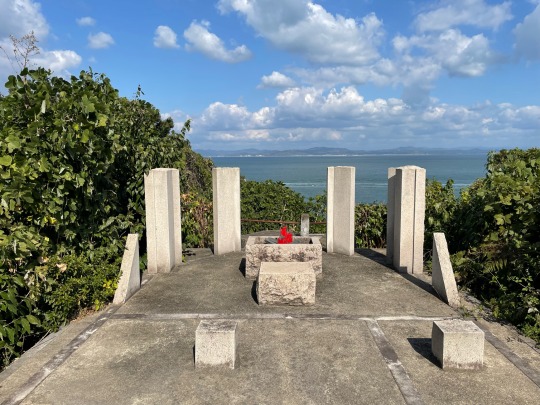

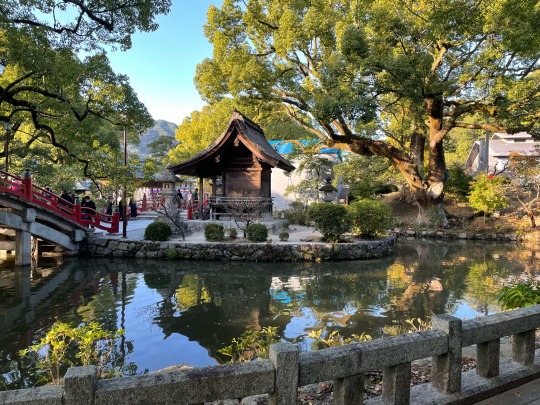



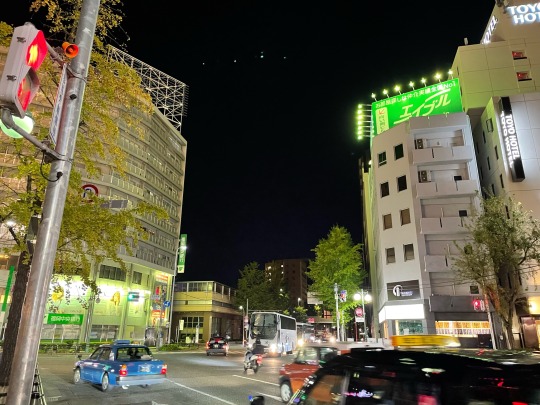
Laurdag 5. november
Siste dag ilag på tur for denne gong! Frå no av deler me på oss, eg blir eit par dagar i Seoul, og Rune reiser til Osaka. Me var allereie kome til Fukuoka, så me nytta høvet til å utforske nordaust-delen av Kyushu. Starta med å køyre kystvegen ut av Fukuoka til me kome til Kitakyushu. Her hadde me eit lite stopp for å sjå på det nordlegaste punktet på Kyushu samt eit fyrtårn i nærleiken.
Turen gjekk deretter sørover gjennom dalane og over fjella til me kom til Dazaifu. Her er det fleire Shinto-shrine og Buddhist-tempel, mellom anna det viktigaste for Tenmangu-retninga av Shintoismen. Me forventa ikkje at me skulle vere åleine, men det viste seg å vere litt fleire folk enn me trudde. Mogleg det har noko å gjere med at det er helg. Heldigvis kom me dit utpå ettermiddagen, så me klarte å snike til oss ei parkering. Kikka litt rundt på området og vandra ein tur til Inari-shrinet før me tok fjellvegen attende til Fukuoka.
Sleit litt med trafikken og hotellplasseringane, men me klarte tilslutt å få levert leigebilen og sjekka inn på hotellet. Kvelden vart brukt på mat og drikke, handling og pakking.
0 notes